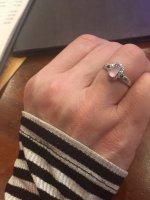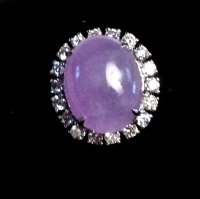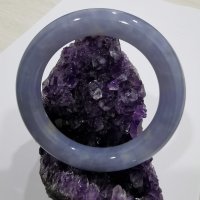You are using an out of date browser. It may not display this or other websites correctly.
You should upgrade or use an alternative browser.
You should upgrade or use an alternative browser.
The JADE thread!
- Thread starter mistikat
- Start date
TPF may earn a commission from merchant affiliate
links, including eBay, Amazon, and others
More options
Who Replied?OMG this is beautiful indeed!!!!! I really think it is so clear. I have not seen lavender this clear. I love it!Sure! Here it is, may as well post some other pieces I’ve acquired recently too!
View attachment 4897983View attachment 4897984View attachment 4897985View attachment 4897986
WOW so informative. Thank you for sharing. I feel like I am attending a gem class.http://mandalay.china-consulate.org/chn/mbly/MDXB/FC/t215173.htm
Google translation:
Classification of jadeite:
The traditional old-fashioned jade grading is always described as dark old pits, old pits, gold wire species, new pit species, oil green species, and bean green species, but for consumers, it can be said that it is too abstract to make consumption Those who are familiar with jade can easily and thoroughly understand it. The following provides a new classification method for reference.
View attachment 4897969
一. Texture (species)
1. Glass floor: The texture is bright, clear and delicate. The most important thing is to have a "hard" feel similar to a single crystal of gemstones, with very few visible stone patterns. If there are visible impurities, it is mostly frozen stone flowers, bagasse or flaky black smoke. After this kind of texture is set, the internal reflected light is often visible, and sometimes there is a "cat's eye" phenomenon. This texture is the highest grade among all germplasms and can be said to remain unchanged for thousands of years.
2. Iceland: As the name suggests, its crystals feel like ice cubes or sugar candy, and the cleanliness is quite high. The texture is also quite detailed, but it doesn't feel as cold or hard as the glass. This texture is quite good after setting the head.
3. Transformed ground: Its texture is like the translucent shape of "jelly", but tiny stone flowers and cotton wool can be seen.
4. Winter melon: The texture is also close to translucent, and it feels like a cooked winter melon.
5. Glutinous rice: The texture should be impervious, with a delicate feeling like cooked glutinous rice, which is generally called hibiscus and this texture is close to it.
6. Inverted ground: The texture is similar to glutinous rice ground, but part of the crystals in the jade meat appear as rice residue like uncooked raw rice.
7. Bean field: It is not very transparent like beans, the transparency is only half of the surface, there are many visible cotton willow, fly wings, rice porridge residue, etc. This texture will easily get small white flowers in the future when it is exposed to strong light for a period of time , "Pride" is reduced.
8. White ground: Generally, the crystals of jade are mostly white and colorless, and white is the most common color. Most of the aforementioned new factory jade only reach this level. This texture has no transparent mood. This texture is often called "" Porcelain ground "approaching.
9. Taro ground: White is slightly grayish, the color is like taro, and the bottom is wood.
10. Grey ground: opaque, multi-fiber texture, dark like fragrant gray, with sandy character.
11. Udi: The texture is dark brown, opaque, and wood bottom.
12. Oily field: the seeds are ice and hard, and the oily luster feels floating on the surface. Generally, jadeite with a darker color is more likely to appear.
二. Color:
View attachment 4897970View attachment 4897969View attachment 4897970View attachment 4897969View attachment 4897969View attachment 4897970
1. Brilliant green: pure green, pure and dense, but without black.
2. Green: Green is slightly bluish, which is called green and bluish from a gemological point of view. It is because of its blue and green colors that it looks calm and mysterious, giving people a more "shen" feeling.
3. Emerald green: green is alive. If it is born in a glass floor, it will shake like green water. The color is brighter and lighter, which is the representative of standard green.
4. Yang green: The green is bright and sunny, with a slight yellowish color, and because of its yellow flavor, the green has a bright sense of life.
5. Light green: Green is lighter, not fresh enough.
6. Turbid green: The color is darker than light green, but slightly turbid.
7. Dark green: Although the color is thick but dark, it is not fresh, but it still loses green.
8. Black and green: Green to dark black.
9. Blue: The color is slightly bluish, slightly greenish, which is called blue-greenish in gemology.
10. Gray: The color is not blue, green or black, with gray.
11. Yellow: Most of the yellow comes from the endothelium, and the texture of the yellow is often the jade species above the winter melon land.
12. Purple: Opposite to emerald, those born in fog are emeralds, and those born in jade flesh are mostly piles (purple) divided into light purple, purple, bright purple and purple.
13. White: This color is the most common in jadeite. When it is born above the chemical land, it is colorless, and when it is born below the bean land, it appears white.
14. Emerald red: mostly from the endothelium, those born in jade flesh are mostly distributed in filaments, and some are formed into pieces. The red color in the crack is the result of the invasion of iron.
15. Black: No green, black ink.
16. Three colors: There are two colors on the white ground called "Fu Lu Shou", and those with three colors are called "Fu Lu Shou Xi".
Four color illustrations (take small seedlings as an example)
Was just reading up on jadeite last time. And kept the article bookmarked for my reference .WOW so informative. Thank you for sharing. I feel like I am attending a gem class.
This really sounds like poetry.http://mandalay.china-consulate.org/chn/mbly/MDXB/FC/t215173.htm
Google translation:
Classification of jadeite:
The traditional old-fashioned jade grading is always described as dark old pits, old pits, gold wire species, new pit species, oil green species, and bean green species, but for consumers, it can be said that it is too abstract to make consumption Those who are familiar with jade can easily and thoroughly understand it. The following provides a new classification method for reference.
View attachment 4897997View attachment 4897997
View attachment 4897969
一. Texture (species)
1. Glass floor: The texture is bright, clear and delicate. The most important thing is to have a "hard" feel similar to a single crystal of gemstones, with very few visible stone patterns. If there are visible impurities, it is mostly frozen stone flowers, bagasse or flaky black smoke. After this kind of texture is set, the internal reflected light is often visible, and sometimes there is a "cat's eye" phenomenon. This texture is the highest grade among all germplasms and can be said to remain unchanged for thousands of years.
2. Iceland: As the name suggests, its crystals feel like ice cubes or sugar candy, and the cleanliness is quite high. The texture is also quite detailed, but it doesn't feel as cold or hard as the glass. This texture is quite good after setting the head.
3. Transformed ground: Its texture is like the translucent shape of "jelly", but tiny stone flowers and cotton wool can be seen.
4. Winter melon: The texture is also close to translucent, and it feels like a cooked winter melon.
5. Glutinous rice: The texture should be impervious, with a delicate feeling like cooked glutinous rice, which is generally called hibiscus and this texture is close to it.
6. Inverted ground: The texture is similar to glutinous rice ground, but part of the crystals in the jade meat appear as rice residue like uncooked raw rice.
7. Bean field: It is not very transparent like beans, the transparency is only half of the surface, there are many visible cotton willow, fly wings, rice porridge residue, etc. This texture will easily get small white flowers in the future when it is exposed to strong light for a period of time , "Pride" is reduced.
8. White ground: Generally, the crystals of jade are mostly white and colorless, and white is the most common color. Most of the aforementioned new factory jade only reach this level. This texture has no transparent mood. This texture is often called "" Porcelain ground "approaching.
9. Taro ground: White is slightly grayish, the color is like taro, and the bottom is wood.
10. Grey ground: opaque, multi-fiber texture, dark like fragrant gray, with sandy character.
11. Udi: The texture is dark brown, opaque, and wood bottom.
12. Oily field: the seeds are ice and hard, and the oily luster feels floating on the surface. Generally, jadeite with a darker color is more likely to appear.
二. Color:
View attachment 4898002View attachment 4898002
View attachment 4897970View attachment 4897969View attachment 4897970View attachment 4897969View attachment 4897969View attachment 4897970
1. Brilliant green: pure green, pure and dense, but without black.
2. Green: Green is slightly bluish, which is called green and bluish from a gemological point of view. It is because of its blue and green colors that it looks calm and mysterious, giving people a more "shen" feeling.
3. Emerald green: green is alive. If it is born in a glass floor, it will shake like green water. The color is brighter and lighter, which is the representative of standard green.
4. Yang green: The green is bright and sunny, with a slight yellowish color, and because of its yellow flavor, the green has a bright sense of life.
5. Light green: Green is lighter, not fresh enough.
6. Turbid green: The color is darker than light green, but slightly turbid.
7. Dark green: Although the color is thick but dark, it is not fresh, but it still loses green.
8. Black and green: Green to dark black.
9. Blue: The color is slightly bluish, slightly greenish, which is called blue-greenish in gemology.
10. Gray: The color is not blue, green or black, with gray.
11. Yellow: Most of the yellow comes from the endothelium, and the texture of the yellow is often the jade species above the winter melon land.
12. Purple: Opposite to emerald, those born in fog are emeralds, and those born in jade flesh are mostly piles (purple) divided into light purple, purple, bright purple and purple.
13. White: This color is the most common in jadeite. When it is born above the chemical land, it is colorless, and when it is born below the bean land, it appears white.
14. Emerald red: mostly from the endothelium, those born in jade flesh are mostly distributed in filaments, and some are formed into pieces. The red color in the crack is the result of the invasion of iron.
15. Black: No green, black ink.
16. Three colors: There are two colors on the white ground called "Fu Lu Shou", and those with three colors are called "Fu Lu Shou Xi".
Four color illustrations (take small seedlings as an example)
I know right?! I was lucky to have it sold for $980, cause in NY it would've easily been at the $2k-$3k range.OMG this is beautiful indeed!!!!! I really think it is so clear. I have not seen lavender this clear. I love it!

A lavender cabochon like that in 1 ct can just easily break my bank even without the gold setting.
I would have bought that in a second. Lucky indeed. Where did you get it from? Do you live in NY?I know right?! I was lucky to have it sold for $980, cause in NY it would've easily been at the $2k-$3k range.
A lavender cabochon like that in 1 ct can just easily break my bank even without the gold setting.
This looks icy deep lavender to me, Silver mum. It’s so beautiful .Adjadecent Angle and szuszuszu this is my last purchase. Would you guys classify this as glutinous? I don't know what classification this would be because it is a bit different from my bangle but also similar. Not sure what type it is. View attachment 4898015
I was told by my seller that glutinous type would like the translucency of a cooked glutinous rice grain. Something to this effect when you zoom into a cooked grain. However I’ve come across descriptions “icy glutinous” as well. The jadeite looked “gluey” in texture (not obvious grains) but are more transparent.This looks icy deep lavender to me, Silver mum. It’s so beautiful .
Attachments
I got it online and yeah I doI would have bought that in a second. Lucky indeed. Where did you get it from? Do you live in NY?
 everything involving jewelry and NY together just will scream pricy.
everything involving jewelry and NY together just will scream pricy.Also I agree with szuszu, although the photo is pretty blurry so I can't really see it's structure, it definitely seems like an icy variety of lavender jade
Ohhh these pictures are so informative. Don't have to be sorry. Really appreciate your taking the time to post these.Oops. Sorry about the multiple duplicate images. Using my phone to post this.
Now that’s an eyecatcher if I’ve ever seen one!Showing my purple bangle since we are on the topic of purple too haha. It is a tad too big for me but because it is darker shade of purple! The colour still remains vibrant under sunlight.View attachment 4898167View attachment 4898168
Also I did something a tad embarrassing very recently, I found a Chinese jade facebook page where they operate in Hong Kong and saw they were live, I decided to chat not in Cantonese, but in English and boy did I feel ashamed to be an Asian American for a good minute. Luckily they were nice to me and knew alittle bit of English and decided to showcase some of their jade products!

Here are the pics I’ve enquired about:

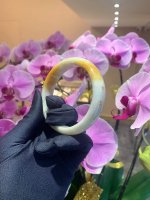
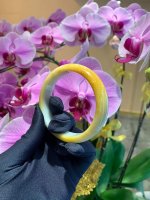
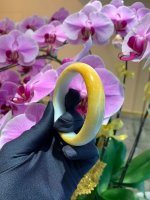
So pretty. Is this a princess round?Showing my purple bangle since we are on the topic of purple too haha. It is a tad too big for me but because it is darker shade of purple! The colour still remains vibrant under sunlight.View attachment 4898167View attachment 4898168
Register on TPF! This sidebar then disappears and there are less ads!



